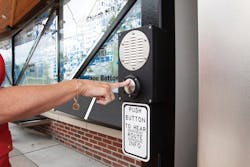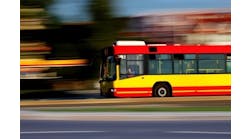In partnership with the U.S. DOT, the Commonwealth of Virginia (comprising the Virginia Department of Rail and Public Transportation [DRPT] and Virginia DOT [VDOT]), the city of Richmond, and Henrico County, GRTC launched its Pulse bus rapid transit (BRT) service in June 2018.
GRTC Pulse is a modern, high-quality, high-capacity, BRT system in Central Virginia that serves a 7.6-mile route along Broad Street and Main Street, from Rocketts Landing in Richmond to Willow Lawn in Henrico County. Portions of the route use dedicated bus-only lanes, including in the median and on the curbside. GRTC Pulse is jointly sponsored by Bon Secours Richmond Health System and VCU Health System. The Pulse links to many exciting destinations, businesses, and services and has become GRTC’s most popular bus route, carrying more than 6,000 riders on weekdays and up to 43,000 riders weekly.
With preparation spanning about a decade, the Pulse began as a BRT concept for exploration by DRPT and GRTC in 2008. “The Broad Street Corridor Rapid Transit Study” study activities started in 2010 and concluded in 2014. They included coordination with stakeholder groups, alternatives assessment, and development of environmental impact analysis. After completion of the Broad Street Rapid Transit Study in Spring 2014 and with endorsements and assistance from the Virginia DRPT, the city of Richmond, and Henrico County, GRTC applied for a TIGER grant from the U.S. DOT, and in September of that year was awarded $24.9 million. Overall cost of the GRTC BRT Project was supported with matching funds from the Commonwealth of Virginia, the city of Richmond, and Henrico County. The project team completed the Preliminary Engineering Phase in July 2015. The team began the semifinal design in August 2015 and completed it in October 2015. The design-build procurement process started in September 2015 and ended in April 2016 with an award to Lane Construction Corp.
Construction began in Summer 2016. Before opening to the public, BRT operations were tested and accepted in Spring 2018, with a public opening that June.
All told, a decade’s work is already paying off with increasing ridership and customer satisfaction.
FINDING THE FIT
The Pulse design had to fit within the existing right-of-way in an already developed urban environment, while also taking into consideration community priorities of pedestrian safety, on-street parking, left-turn vehicular access, signal timing, median and lane widths, and station amenities. Richmond, as the capital of the Commonwealth, has historic areas dating back to the 1600s, including buildings still standing from the 1700s. Considering the historic context and architectural language spoken throughout the city, the station designers proposed a uniquely “Richmond” design using red brick, dark steel, warm wood, and glass. Red brick is one of the most common building materials historically used in Richmond. The dark steel mirrors Richmond’s train trestles and represents railroad history. The stations also include both benches and lean rails, as well as space for passengers in mobility devices, with the entire platform waiting area under roof. In addition to being aesthetically pleasing and functional for a buffer from the elements, the rear glass includes an artistic rendering map of the route and surrounding neighborhoods with embedded QR codes to scan and load more information about destinations nearby. An innovative real-time arrival display is at each station’s totem, a tall, brick station name that has green lights which illuminate and rise as the next bus gets closer to arriving. This five-minute countdown provides another visual cue for passengers nearby to know it is time to validate their fare and prepare to board.
Other key BRT elements were incorporated at the station, including platform-level boarding, all-door boarding/alighting, off-board fare collection with on-board fare enforcement patrols, and real-time arrival information (both visual and audial). Bicycle connectivity was also important to the design, where bike parking is provided at all stations and a loading ramp is available (for median stations) to safely reach street level and for front-of-bus bike loading. Buses can store up to three bicycles.
Bus selection deliberately chose equipment proven for success. GRTC as a system is committed to transitioning to alternative fueled compressed natural gas (CNG) buses by 2024. The entire Pulse fleet runs on CNG, making the service cleaner and quieter. Based on ridership projections and headways, GRTC ordered 10 40-ft Gillig CNG BRT+ buses, with two doors on the passenger side opening onto the platforms. Each bus can hold approximately 55 passengers, including standees. The majority of GRTC’s fleet is also Gillig buses, which made the incorporation of the Pulse Gilligs with maintenance seamless. The Pulse buses were calibrated to match the 15-in. platform height docking requirement, and the doors were slightly modified for smoother operations at the platforms.
Finally, the branding was another essential BRT component for the Pulse. Pulse buses are branded differently from the rest of the fleet, visually distinguishing the service. The branding and marketing process began during the early design phase in late 2014, when GRTC collaboratively led a focus group with project partners and stakeholders. The result of this effort included a bus design, as well as the service name, logo, and tagline, all of which are trademarked.
The “GRTC Pulse” name and logo represent several themes, including the Richmond skyline as a heartbeat line for the region. The predominant, vibrant, and lively blue color represents water (the James River) and emotes strength, trust, and dependability from the Color Emotion Guide, while the green color feels “electric” and is the same green used throughout GRTC’s branding for a familiar consistency. The name and logo were also selected to be attractive to potential local sponsors of the service, modeled on Cleveland Healthline’s success. The tagline, “More Time For Life,” conveys the themes of faster, more convenient service, which permits more time to spend with family, get to work, recreate and engage in sport, and explore local history and culture. These thematic stories under the “More Time For Life” umbrella were told through the 2018 marketing campaign pre- and post-launch of the service.
TALKING IT UP
Communication with stakeholders and the public was a top priority during the August 2016–June 2018 construction period. GRTC conducted in-person outreach along the entire 7.6 miles of the route, building contacts and establishing a trusted line for communication. Weekly email and website updates provided the most up-to-date construction information available, and a construction hotline was maintained with 24/7 access to updates or help. Participation in large community events also elevated public awareness of the coming BRT service. In addition to newspaper, radio, and TV advertisements, the public could also engage directly with the contractor on a quarterly basis through public meetings.
Because the delivery method was design-build, a process for which VDOT is nationally recognized, the contractor had flexibility to adjust its work plan as needed to best accomplish its tasks. Initially, the contractor laid out a station grouping approach to construction, but this process evolved more in line with tasks. For example, when the contractors had non-station work they could accomplish, such as ADA upgrades at intersections, they would do this work. This flexibility ensured the project was completed on time and within budget. Richmond is an old city and, despite utility records, has old, unmarked conflicts that can be encountered. Utility work was the first phase of construction and ensured that by the time crews were ready to construct stations they had resolved any conflicts.
GIVING PRIORITY
The Pulse uses transit signal prioritization (TSP), which was a new technology for Richmond. GRTC Pulse benefits from both a prolonged green at intersections and a queue jump at specific intersections where the bus needs to merge before other travel lanes. TSP helps the buses stay on time and safely negotiate travel while sharing the road with other users and uses. In addition to the technology upgrades, there were 56 intersections with traffic engineering updates. Bus-only lanes previously existed downtown on the curbside, but Richmond had not seen transit operate in dedicated lanes in the middle of the street since the pre-1950 streetcar trolley days.
The design of the median stations and bus-only lanes required accommodation for the safety of all users of the corridor. For example, human pedestrian behavior does not mean all pedestrians will cross the street at signalized crosswalks when they have the right-of-way. Median pedestrian refuge was created with widths of 4 ft in most locations, 2 ft at left-turns, and 6 ft at the VCU Monroe Park campus. Stations have protected pedestrian access with railings and walls, and most passengers exiting the Pulse have timed access to exit the median platforms and reach the curbside within that signal cycle. Bus lane widths were increased to 11 ft to ensure ample mirror-to-mirror space and mitigate common minor incidents of “mirror-slap” by other vehicles.
The Pulse serves as the spine of GRTC’s new bus network, with completely redesigned bus routes in Richmond, service adjustments and expansions in Henrico County, and additional connectivity for express routes downtown. Local routes prioritize frequency (every 15 minutes). Customers can make convenient connections with shorter waits between the Pulse and other routes, where stops and stations are located within two blocks or less of each other.
Opening week far exceeded expectations for ridership, aided by the Commonwealth of Virginia funding free rides on all GRTC routes (except the seasonal express). Customers could try the Pulse and the other new routes fare-free, hopping on and off to explore destinations and get comfortable with the new schedules and connections between buses. The first week of Pulse service, nearly 57,000 riders tried the new bus rapid transit line. Total ridership that week on GRTC’s network was a phenomenal 250,000 riders.
Today, the Pulse carries more than 6,000 riders each weekday, with weekly ridership ranging 36,000–43,000. Comparing year-over-year, GRTC’s total ridership has increased 12%. GRTC is one of only a few transit systems in the country currently experiencing an increase in ridership. That makes for a singular model of success.



